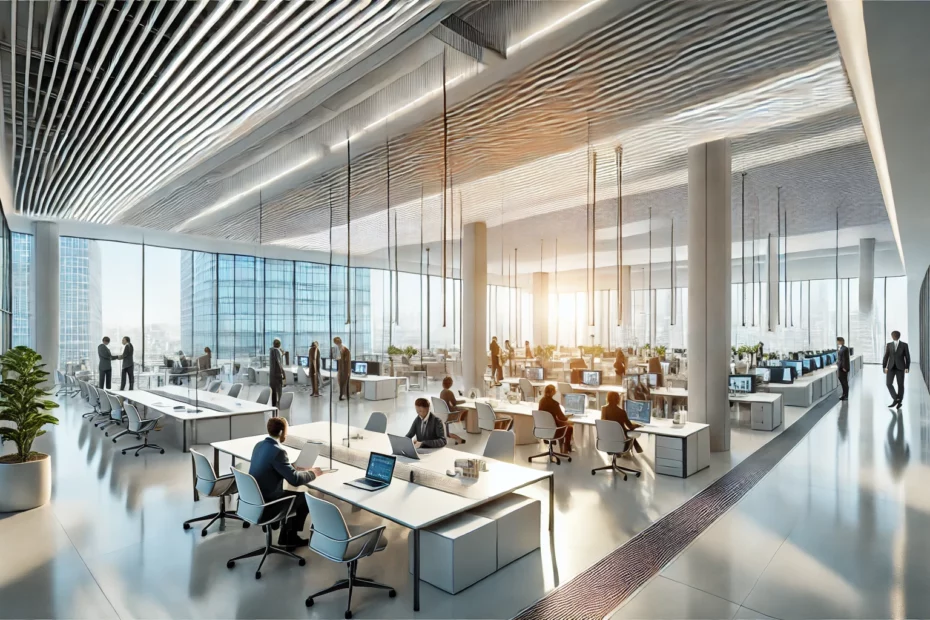Thermal comfort in an office or professional space is essential to ensure employee productivity and well-being. An efficient heating system must not only provide pleasant warmth, but also be energy-efficient and unobtrusive in its installation. Radiant ceiling heating meets these requirements, making it an ideal solution for offices and other professional environments. Let’s take a look at the advantages of radiant ceiling heating.
In this article, we’ll explore the key benefits of radiant ceiling heating for workspaces.
Optimum comfort for a productive working environment
Radiant ceiling heating provides even thermal comfort throughout the workspace. Unlike convection heating systems, which can create draughts or areas of overheating, radiant heating diffuses heat gently and evenly. This helps maintain a stable temperature, even in large offices or open spaces, without sudden variations in heat.
For employees, this comfort is essential. Too low or too high a temperature can affect concentration and productivity. Ceiling heating therefore ensures a pleasant working environment, conducive to performance.
Lower energy costs for businesses
In addition to improving comfort, radiant heating is also energy-efficient. This system directly heats objects, surfaces and people in the room, rather than heating the air. This approach limits heat loss, particularly in large spaces or poorly insulated buildings.
Solutions like the Modular Radiant Ceiling (PRM) are particularly effective for offices, as they enable spaces to be heated quickly, even in high-traffic areas. This rapid heating and the ability to regulate temperature according to the specific needs of different areas of the building mean significant savings on energy bills.
Discreet integration and design in professional spaces: the advantages of radiant ceiling heating
Another advantage of radiant ceiling heating is its discreet integration into professional spaces. Systems such as PRM or Plaster Radiant Ceiling (PRP) are installed directly in the ceiling, without taking up wall or floor space. This maximizes the space available for office furniture and equipment, while ensuring an aesthetically uncluttered environment.
This discretion is particularly appreciated in modern offices, where aesthetics play a key role in creating an inspiring and functional working environment. What’s more, the absence of visible radiators or systems frees up walls and simplifies office layout.
Adaptable to the specific needs of professional spaces
Offices and other professional spaces can vary in size, configuration and use. Radiant ceiling heating is a flexible solution that can adapt to these different needs. Whether for individual offices, meeting rooms or large open spaces, PRM and PRP systems offer a tailor-made solution for every type of space.
What’s more, it’s possible to zone heating, i.e. to create distinct temperature zones according to the use of each space. This optimizes energy efficiency by heating only occupied areas, thus avoiding energy wastage in unoccupied spaces.
A sustainable, environmentally-friendly choice
Radiant heating is also an environmentally-friendly choice for companies wishing to reduce their environmental impact. By consuming less energy than traditional systems, it helps to reduce the carbon footprint of professional buildings. Technologies such as PRM and PRP are designed to last for many years, limiting the need for replacement and maintenance.
By opting for radiant ceiling heating, companies make an economical, aesthetic and environmentally-friendly choice that meets the demands of modern offices.
- What is a hydraulic heating ceiling? Definition and operating principles
- Hydraulic ceiling heating vs. underfloor heating: Which solution is more efficient?

- The advantages and disadvantages of hydraulic ceiling heating: Complete guide

- The Myth of Rising Heat: Demystifying and Explaining the Heated Ceiling

- Radiant Heating Ceilings : The Revolutionary Efficiency of an Unprecedented System


